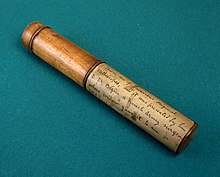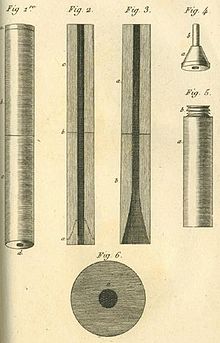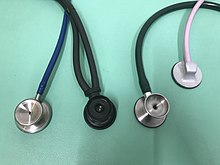stethoscope

The stethoscope is a diagnostic tool for assessing sound phenomena inside hollow bodies.
Its name as a device for the indirect eavesdropping ( auscultation ) of the organs heart and lungs located in the chest is formed neoclassically by its inventor René Laënnec in French as a stéthoscope (“ breast monitor ”) and borrowed from French into German (Greek στῆθος stēthos ' breast) '; French -scope , German -skop , Greek σκοπεῖν skopein = look at, look, look, examine).
Typical effective head diameters are 30 to 46 mm. With double-tube stethoscopes, two tubes extend from the head.
The stethoscope is also used in mechanical engineering , for example to be able to recognize machine damage at an early stage via bearing noises or to be able to detect the running of a heating circulation pump. Such a motor or bearing tester is held with its possibly slightly bent, 20 to 30 cm long needle equipped with a tip or contact buffer at the point to be monitored for structure-borne noise. The other end of the needle generates airborne sound via a membrane or can with a diameter of about 30 mm, which is guided to the ears via axially extending hoses and brackets.
In human and veterinary medicine , tones and noises that arise in connection with the activity of the heart , lungs and intestines are assessed with the stethoscope . Every physical examination includes auscultation of the heart valves and sometimes also of the carotid arteries to rule out abnormal flow noises or transmitted pathological heart sounds. When measuring blood pressure , a stethoscope is used to hear Korotkow's flow noises .
A binaural stethoscope with a double membrane chest piece and two parallel tubes is also called a phonendoscope according to Nikolai Sergejewitsch Korotkow , a term that is rarely used nowadays.
Types
Acoustic stethoscopes
Today, stethoscopes are acoustic or classic stethoscopes that use simple physical phenomena to make body noises more audible. Simple stethoscopes are funnel-shaped ear tubes made of wood. They are still used today in prenatal diagnostics and are known as Pinard tubes .
The most common stethoscopes consist of the three basic elements: ear hook, tube and chest piece (or “head”). In the chest piece there is a membrane that absorbs the acoustic waves, causing them to vibrate itself and passing them on to the air column in the stethoscope tube. The waves are directed to the examiner's eardrum via the ear hooks (tubes) . The "olives" made of hard or (better) soft plastic at the end of the ear hook seal the ear canals. This stethoscope is also called a flat-head stethoscope.
The two ear hooks are connected at their bases by a spring clip, which presses the olives lightly into the ear canals or brings them together behind the neck when not in use. If the hose bifurcation is long enough, the spring clip can have a hinge in order to be able to fold the ear clips together to save space for storage.
On some models, the chest piece can be rotated 180 °. As an alternative to the side with a membrane, there is a funnel without a membrane. This funnel enables a better representation of the deeper frequency spectrum . This is particularly relevant in cardiology . This stethoscope is called a double head stethoscope, the head itself is called a double head chest piece. There are also double-head stethoscopes that also have a membrane on the second side, but with a smaller diameter for examining small bodies. The non-resting side of the head must be closed with a fingertip or two fingers.
Due to a special membrane construction, some stethoscopes can emphasize different frequency ranges depending on the contact pressure of the membrane. When the contact pressure is low, the lower frequencies are emphasized, as is the case with the funnel, while the higher-frequency sound waves are emphasized when the contact pressure is higher.
A certain mass of the head is expedient, since it should remain at rest in relation to the body that is being listened to vibrating on its surface, so that air in the head is compressed. The pneumatically active surface of the funnel or membrane on the head to the lumen of the hose and bracket form a translation that increases the audible volume through adjustment.
When using a double head, the non-applied side is closed as well as possible with a fingertip or 2 fingers, provided this is not done by turning the chest piece.
Valid acoustic quality differences within the classic, purely mechanical stethoscopes cannot be proven in metrological or objective comparisons. A hose that is as short and stiff as possible, as well as well-sealing olives to shield from interfering noises are advantageous for auscultation, as proven by the extensive experiments by Sprague and Rappaport, which they carried out in the first half of the 20th century. The Sprague-Rappaport stethoscopes are named after Sprague, a Boston cardiologist, and Rappaport, his technical engineer. The invention of the "combination stethoscope", consisting of a double-headed chest piece with a funnel on one side and a membrane on the other, goes back to David Littmann . Since then, it has made it easier to hear high and low frequency sounds. In 1963 he applied for a patent for his development . The price range for mechanical stethoscopes is generally very large, brand stethoscopes sometimes cost well over 100 EUR.
Stethoclip
The stethoclip is a classic stethoscope without a chest piece commonly used in hearing aid acoustics. The open end of the tube of the stethoclip can be attached directly to the angle of the hearing aid and thus enables the technology to be listened to with almost no noise and no sound loss through filters or membranes.
Electronic stethoscopes
Various stethoscope manufacturers now also offer electronic stethoscopes - which are intended to electronically amplify sound, emphasize various tones and eliminate background noises (such as ambient and friction noises). Sounds can also be recorded and played back or transmitted to a computer. Auscultation of the coronary arteries using electronic stethoscopes is currently in clinical trials.
Stethoscopes that can be controlled via smartphones are also on the market. The tones are recorded by means of a membrane that can be attached directly to the mobile phone. The recordings can be saved, analyzed and made visually visible. We are working on an automatic interpretation using artificial intelligence.
history
The stethoscope was developed in 1816 by René Laënnec in France. Since he did not want to put his ear directly on the chest of a young patient, as was customary at the time, he used a roll of paper as an "ear tube". After he had established that his hearing was not worse, but even better, he pushed ahead with the development of the stethoscope, initially in the form of the wooden ear tube.
The illustrated ear trumpets from the 19th century are described in Meyers Konversations-Lexikon as follows:
“The stethoscope is a 26–31 cm long tube made of wood with a funnel-shaped bottom and a round disc, the so-called ear plate, usually made of ivory . The lower end, about 2.6–3.9 cm in diameter, must be rounded so that it does not cut painfully when it is placed on the skin of the body. When using the stethoscope, you grasp the funnel-shaped end, place it exactly on the surface of the part of the body to be examined so that it sits firmly all around, and then place your ear on the ear plate. "
The current technique of auscultation goes back to the Austrian physician Josef von Škoda (1839).
The first stethoscopes with flexible tubing were developed by doctors Arthur Leared and George Cammann in the 1850s. They had a funnel-shaped end piece and two ear pieces. The Italian Aurelio Bianchi finally invented a stethoscope with a water seal in 1884, thus creating the basis for a modern membrane chestpiece.
hygiene
A cross-sectional study by the University of Houston found that only 18% of stethoscopes are disinfected. Only in 4% of the cases was the disinfection carried out in accordance with the guidelines applicable in the USA. Stethoscopes are colonized by numerous bacteria, including nosocomial pathogens - often even after cleaning. Typically, bacteria of the genera Porphyromonas gingivalis , Bacteroides , Granulicatella , Actinomyces , Prevotellaceae , Streptococci , Staphylococci , Corynebacterium and Propionibacteria were found. Enterococci , Stenotrophomonas maltophilia and clostridia were found on about half of the instruments . Especially for people with larger open wounds, burns or immunocompromised patients present contaminated stethoscopes is an unnecessary potential danger. If anything, be hand sanitizer and pre-saturated wipes for surface disinfection used. According to the Medical Devices Act, however, these are not per se permissible because the stethoscope as an instrument must be reprocessed with an instrument disinfectant.
See also
literature
- M. Donald Blaufox: An Illustrated History of the Evolution of the Stethoscope. Parthenon Publishing, 2001, ISBN 978-1-85070-278-8 .
- U. Koehler, V. Gross, C. Reincke, T. Penzel: The History of Percussion and Auscultation. In: Pneumology. 58, 2004, pp. 525-530, doi : 10.1055 / s-2004-818416 .
- Werner Bartens : Hearing Medicine . In: Süddeutsche Zeitung . January 26, 2014.
- TRH Laennec: De l'Auscultation médiate ou traité du diagnostic des maladies des poumons et du coeur. Paris 1819.
Web links
- The stethoscope , medizinlehrbuecher.de
- The history of the stethoscope , collection of text sources
Individual evidence
- ↑ Werner E. Gerabek , Bernhard D. Haage, Gundolf Keil, Wolfgang Wegner: Enzyklopädie Medizingeschichte , Walter de Gruyter Verlag 2004, ISBN 978-3-11-015714-7 online
- ↑ Peter König, Axel Rossmann: Advice for gas turbine operators . Vulkan-Verlag, Essen 1999, ISBN 3-8027-2545-X , p. 155 ( limited preview in Google Book search).
- ↑ Nursing Stethoscope ( Memento of 13 April 2015, Internet Archive )
- ↑ Dual Frequency Technology
- ↑ DasStethoskop.de
- ↑ Maurice B Rappaport, Howard B Sprague: Physiologic and physical laws that govern auscultation, and their clinical application. In: American Heart Journal . 21, 1941, pp. 257-318, doi : 10.1016 / S0002-8703 (41) 90904-3 .
- ↑ 3M ™ Littmann® Stethoscope, History
- ↑ Steth IO launches digital stethoscope housed within smartphone case . In: MobiHealthNews . April 24, 2018 ( mobihealthnews.com [accessed June 21, 2018]).
- ↑ Visualizing Auscultation | Steth IO . In: Steth IO . ( stethio.com [accessed June 21, 2018]).
- ↑ The history of the stethoscope , Lehmanns WissensBox. Retrieved May 11, 2017.
- ↑ What moistens the stethoscope pig , March 29, 2019. Retrieved March 30, 2019.





